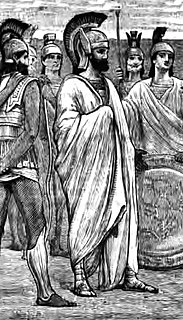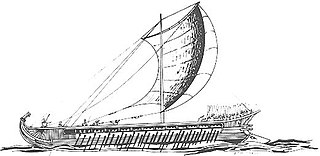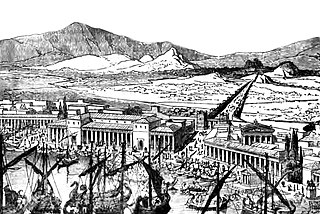 W
WAgesilaus II, was a king (basileus) of the ancient Greek city-state of Sparta and a member of the Eurypontid dynasty ruling from 398 to about 360 BC, during most of which time he was, in Plutarch's words, "as good as though commander and king of all Greece", and was for the whole of it greatly identified with his country's deeds and fortunes. Small in stature and lame from birth, Agesilaus became ruler somewhat unexpectedly in his mid-forties. His reign saw successful military incursions into various states in Asia Minor, as well as successes in the Corinthian War; however, several diplomatic decisions resulted in Sparta becoming increasingly isolated prior to his death at the age of 84 in Cyrenaica.
 W
WAnaxibius, was the Spartan admiral stationed at Byzantium in 400 BC, to whom the Greek troops of Cyrus the Younger, on their arrival at Trapezus on the Euxine, sent their general, Cheirisophus, to obtain a sufficient number of ships to transport them to Europe.
 W
WAntalcidas, son of Leon, was an ancient Greek soldier, politician, and diplomat from Sparta.
 W
WThe Battle of Aegospotami was a naval confrontation that took place in 405 BC and was the last major battle of the Peloponnesian War. In the battle, a Spartan fleet under Lysander destroyed the Athenian navy. This effectively ended the war, since Athens could not import grain or communicate with its empire without control of the sea.
 W
WClearchus or Clearch, the son of Rhamphias, was a Spartan general and mercenary, noted for his service under Cyrus the Younger.
 W
WAlthough long walls were built at several locations in ancient Greece, notably Corinth and Megara, the term Long Walls generally refers to the walls that connected Athens main city to its ports at Piraeus and Phaleron. Built in several phases, they provided a secure connection to the sea even during times of siege. The walls were about 6 km in length, initially constructed in the mid 5th century BC, destroyed by the Spartans in 403 BC after Athens' defeat in the Peloponnesian War, and rebuilt again with Persian support during the Corinthian War in 395-391 BC. The Long Walls were a key element of Athenian military strategy, since they provided the city with a constant link to the sea and thwarted sieges conducted by land alone.
 W
WLysander was a Spartan admiral who commanded the Spartan fleet in the Hellespont which defeated the Athenians at Aegospotami in 405 BC. The following year, he was able to force the Athenians to capitulate, bringing the Peloponnesian War to an end. He then played a key role in Sparta's domination of Greece for the next decade until his death at the Battle of Haliartus.
 W
WPausanias was the Agiad King of Sparta; the son of Pleistoanax. He ruled Sparta from 445 BC to 426 BC and again from 408 BC to 395 BC.
 W
WThe Peloponnesian League was an alliance in the Peloponnesus from the 6th to the 4th centuries BC, dominated by Sparta. It is known mainly for being one of the two rivals in the Peloponnesian War, against the Delian League, which was dominated by Athens.
 W
WPhlius or Phlious or Phleious was an independent polis (city-state) in the northeastern part of Peloponnesus. Phlius' territory, called Phliasia (Φλιασία), was bounded on the north by Sicyonia, on the west by Arcadia, on the east by Cleonae, and on the south by Argolis. This territory is a small valley about 900 feet (270 m) above the level of the sea, surrounded by mountains, from which streams flow down on every side, joining the river Asopus in the middle of the plain. The mountain in the southern part of the plain, from which the principal source of the Asopus springs, was called Carneates (Καρνεάτης). The territory of Phlius was celebrated in antiquity for its wine. According to Strabo, the ancient capital of the country was Araethyrea (Ἀραιθυρέα) on Mt. Celosse, which city is mentioned by Homer; but the inhabitants subsequently deserted it and built Phlius at the distance of 30 stadia. Pausanias, however, does not speak of any migration, but says that the ancient capital was named Arantia (Ἀραντία), from its founder Aras, an autochthon, that it was afterwards called Araethyrea from a daughter of Aras, and that it finally received the name of Phlius, from Phlias, a son of Ceisus and grandson of Temenus. The name of Arantia was retained in the time of Pausanias in the hill Arantinus, on which the city stood. Hence the statement of grammarians that both Arantia and Araethyrea were ancient names of Phlius. According to Stephanus of Byzantium, Phlius derived its name from Dionysus and Chthonophyle. Phlius was subsequently conquered by Dorians under Rhegnidas, who came from Sicyon. Some of the inhabitants migrated to Samos, others to Clazomenae; among the settlers at Samos was Hippasus, from whom Pythagoras derived his descent.
 W
WThe Theban–Spartan War of 378–362 BC was a series of military conflicts fought between Sparta and Thebes for hegemony over Greece.